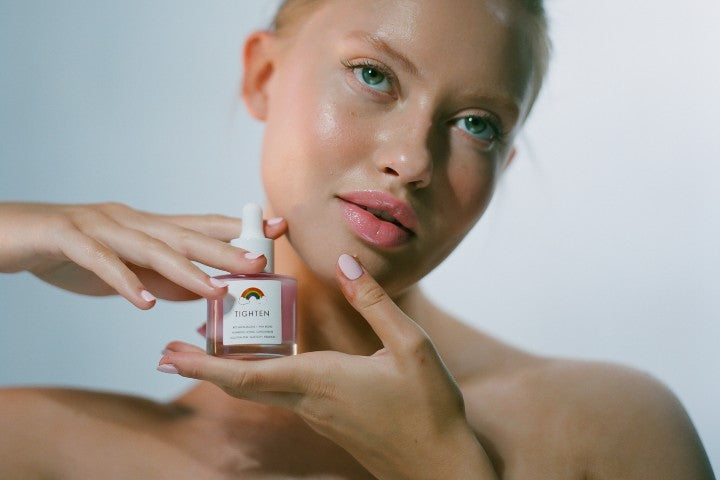The Best Way to Exfoliate

Exfoliation is one of the best ways to improve your skin tone and texture, and it’s something you can do right at home. The question is, how exactly do you exfoliate your skin without ending up red, dry, and irritated?
It is easy to over-exfoliate your skin or use the wrong method for your skin type. Here's how to properly exfoliate for brighter, smoother skin.
EXFOLIATION, EXPLAINED
Exfoliating is the process of removing dead cells from the outer layer of your skin using either a physical or chemical exfoliant. Besides brightening your skin and enabling skincare products to penetrate better, exfoliating is especially helpful at stimulating cell turnover to slow down signs of aging.
Exfoliation is also helpful if you have acne-prone skin, as it helps remove the buildup of oil and dead skin cells that clog pores and trigger breakouts. It can also help fade acne scars faster by stimulating collagen production.
While exfoliation should be part of your regular skincare routine, overdoing it can cause adverse effects such as redness, dryness, and irritation. That's why it's best to exfoliate 2-3 times per week, and less if you have sensitive skin.
WHAT EXFOLIATION CAN DO FOR YOUR SKIN
Whether you've got dry skin, oily skin, or aging skin, every skin type can benefit from regular gentle exfoliation.
Here are the benefits of exfoliation summed up:
- Unclogs pores
- Prevents acne
- Enables other products to absorb better into the skin
- Helps fade dark spots
- Reduces the appearance of fine lines
- Can be helpful in the treatment of keratosis pilaris
- Evens skin tone
- Increases cell turnover
- Brightens skin
- Stimulates collagen synthesis
- Helps to maintain healthy skin
Clearly, there are so many reasons why you need to make exfoliation a regular thing in your routine.
THE TWO DIFFERENT TYPES OF EXFOLIATION
Physical Exfoliation
Also known as mechanical exfoliation, physical exfoliation involves using a tool like a washcloth or face scrub to manually slough away dead skin cells from the skin's surface. While this type of exfoliation is effective at removing dead skin and promoting a smooth, even complexion, it can be irritating to sensitive skin types.
You also need to steer clear of face and body scrubs that contain larger, more abrasive particles that can cause micro tears to the skin.
You can also make your own DIY scrub using sugar, honey, milk for a tasty homemade face and body scrub. Or add it to your body wash for some in-shower resurfacing magic. However, a store bought scrub may be gentler -- and ultimately, a safer option.
Chemical Exfoliation
Chemical exfoliators use ingredients like alpha hydroxy acids (AHAs), beta hydroxy acids (BHAs), and enzymes to loosen the glue-like substance that holds dead skin cells together so they can be removed. Think a face wash with salicylic acid, a toner with glycolic acid, or a serum with lactic acid to dissolve skin cells!
Chemical exfoliation is generally considered better for sensitive skin types as it doesn't involve any rubbing. However, you'll still need to be careful when using these potent ingredients. While they do a great job at dissolving the layers of dead skin and oil, they can cause irritation when used in high concentrations.
Many experts prefer chemical exfoliants as they consider them overall safer, more controlled, and more effective with regular use. Plus, they can help treat acne as well as even out your skin tone for a radiant complexion.
HOW TO EXFOLIATE YOUR SKIN
When using a physical exfoliant, start by washing your face with a gentle cleanser. Next, take a small amount of your face scrub and apply it onto your face in circular motions. Avoid the eye area!
Massage it in for around 30 seconds or as long as the product recommends before rinsing off with warm water and patting your skin dry with a clean towel. Always follow up with a hydrating serum or moisturizer.
When using a chemical exfoliant, begin by washing your face with your daily cleanser. Then--and this is the part that makes all the difference--be sure to only semi-dry your skin so it's still a little damp. When your skin's damp, it absorbs product better, meaning all those active ingredients in your serum will work 10x harder.
Apply the product to your entire face, neck, and décolleté. Let the chemical exfoliant absorb into your skin before following up with a lightweight lotion.
For best results, stick to exfoliating your face one to three times a week, as over-exfoliating can cause dryness and irritation. If you have chronically dry skin, inflammatory acne, or rosacea, ask your dermatologist to determine how often to use an exfoliant.
BEST CHEMICAL EXFOLIANT SKINCARE PRODUCTS
Are you looking for a chemical exfoliant serum? Here are our favorite ones!
Glow Serum
This formula relies on glycolic acid and bakuchiol to loosen the bonds between skin cells, slough away dead skin cells, and brighten skin all-over.
Glycolic acid is an alpha hydroxy acid known for its exfoliating abilities. It combats discoloration and uneven skin texture. Bakuchiol is a natural alternative to retinol that brightens while protecting the skin from environmental stressors and pollution.
Tighten Serum
This power-lifting serum features a blend of red microalgae and alpha hydroxy acids to visibly lift, smooth, and restore elasticity in the skin.
Red microalgae is a powerful antioxidant proven to protect the dermal layer against oxidative stress, resulting in tighter, firmer skin. Alpha hydroxy acids are natural, water-soluble acids that spur on the shedding of dead skin cells and boost collagen production, resulting in a radiant complexion.
The best way to exfoliate really depends on your skin type and the results you're hoping to achieve. With regular exfoliation, you can clear up blemishes, smooth out fine lines and wrinkles, and promote a glowing, even-toned complexion. Remember to extend this knowledge to the rest of your body -- which also needs exfoliation, by the way.
If you're still unsure which type of exfoliation is best for your skin type, visit a dermatologist for professional help and advice.
